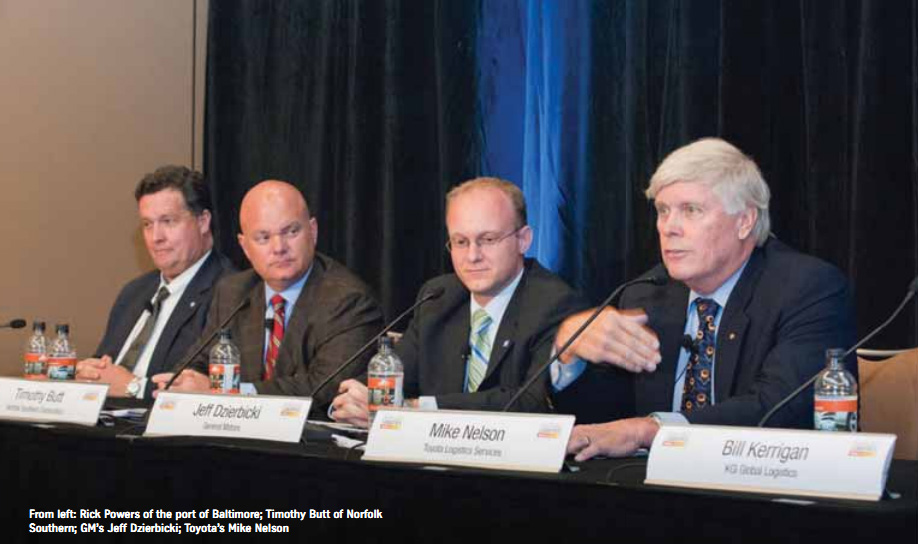
Delegates at Automotive Logistics Global debated the implications of vehicle production growth in Mexico, and whether the industry will offer enough direct services and capacity to handle changing vehicle flows. Marcus Williams reports from Detroit .
The vehicle logistics industry in North America is enjoying a renaissance of growth and investment across all modes of transport.While there are definite signs of efficiency improvements in the individual sectors, a significant shift in manufacturing from Japan and Europe to the US – and particularly Mexico – threw up questions at the recent Automotive Logistics Global conference in Detroit over capacity and transport services for finished vehicles, particularly for shipping and rail. Meanwhile, current growth in the sector has already put some pressure on transport, although for the most part capacity seems to be reasonably balanced and modes such as rail and truck are performing well.
Rail and road capacity better than expected
Mexico looks set to add about 1.5m units of production capacity in the next four years – most of it from Japanese producers – and to capture a higher share of North American production. But OEMs have been expressing concern thatlogistics capacity out of Mexico could be constrained, particularly for rail wagon availability, inland infrastructure, ports and at border points. Indeed, some carmakers already point to problems with movements in Mexico that will only be compounded by growth. Mike Nelson, national manager of rail strategy and operations at Toyota Logistics Services, said Toyota already faces longer cycle times for wagons in Mexico, as well as poor transport visibility. “When we add the Mexico piece, not only is the cycle time going to go up, but once those railcars start moving intra-Mexico we lose them out of the North American system altogether,” he said.
Earlier in 2012, including at the Finished Vehicle Logistics Conference in California, a number of carmakers suggested that vehicles would be backlogged in Mexico as early as the end of 2012. However, the railway performance has been stronger than expected and GM’s executive director for global logistics, Christine Krathwohl, said operators were running the overall network at the fastest velocity for seven years. “I was concerned about the rail network and getting vehicles out of Mexico in the third quarter, but the performance of the railroads has been phenomenal,” she said. “You [the railways] were right and I was wrong. I’m still worried about next year, but it has been a very strong performance.” Chrysler’s head of worldwide vehicle transportation, Steve Tripp, also had positive words about the market’s current vehicle logistics capacity, describing the available fleet as being in a “Goldilocks” state, particularly for road transport. “Vehicle logistics capacity is not too hot, not too cold, not too much, not too little,” he said. “And I think that for the next few years at least, despite the obvious and warranted economic risks, we will stay in the sweet spot, with healthy competition.” However, he also noted that innovation and efficiency would have to play a significant part in outbound development for the future, particularly for the rail and trucking sector, which generally runs around 40% empty, according to OEMs and providers at the conference.
“Those who don’t find that extra two-tenths of a cent per mile in fuel efficiency, or who don’t find more backhaul efficiency, will slowly shrink in business,” he said. Questions remain about future road logistics capacity, particularly out of Mexico. “We don’t have the infrastructure needed to handle the projected growth, from the south to Mexico,” said Bill Kerrigan, director of KGI Global Logistics Consulting. “So what is going to have to change? Are we going to have to see more collaboration between the OEMs?” Other carmakers, including Hyundai, Kia and Porsche, along with carriers such as Waggoners and Proficient have also noted a growing capacity and driver shortage on the road.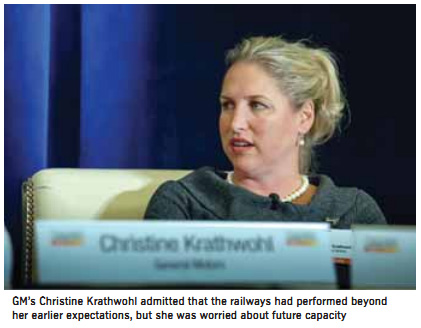
Move to hub-and-spoke distribution
The conference also revealed changes that were likely to take place over the coming years for the ro-ro shipping sector. Not least among these is that production shifts from Asia to North America could lower or level off deep-sea imports from Japan and South Korea to the US. Michael Robinet, managing director of IHS Automotive Consulting, pointed out that flows from Asia to the Americas would decline from 7% of total combined sales in 2000, to 4.6% in 2020.
These changing flows could mean lower cargo density on what are today high-density trunk lanes, which could lead to new distribution and inventory approaches for ro-ro, such as a hub-and-spoke system. According to WWL America’s president Ray Fitzgerald, transport hubs have so far failed to take root in the ro-ro industry segment for vehicle logistics, where direct services have been preferred. Indeed, this preference for direct service has also been the case on land for OEMs with enough volume, largely because carmakers prefer to minimise vehicle handling to reduce lead-time and the potential for damage.
“We want to get direct service between hubs and for the most part we have enough volume to go direct on rail and truck,” said Jeff Dzierbicki, GM’s team lead for vehicle, ocean and rail procurement. “It becomes the most efficient way because it lowers the amount of touch points you have and maintains a higher level of quality.” But hub-and-spoke distribution is nevertheless still more common on land than at sea because of the natural fragmentation and diversity of regional flows. Fitzgerald suggested that changing flows and the growth of new markets could shift the ro-ro sector more in this direction. “In earlier decades, when deep sea transportation lines were concentrated on the trade in automobiles between Japan, Europe and North America, it was fairly easy for the operators to optimise vessel utilisation,” said Fitzgerald. “But over the last 20 years that concentration of cargo has been eroded significantly and that’s a trend that is going to continue. The expanding global economy is creating new markets, driving new distribution channels and it is causing a multiplier effect for destination ports for cargo. It’s a classic case of market fragmentation.” Fitzgerald recognised that the use of more shipping hubs would help shipping lines control costs in the face of high bunker prices and increasing regulatory costs, as well as the fact that the increasing market fragmentation has made it much more difficult to get a return on investment through better utilisation. He also pointed out that in some of the emerging markets, a manufacturer’s expectations for direct services differed widely from what an operator could provide profitably.
The solution, according to Fitzgerald, would be the use of smaller, less expensive vessels trading in regional and inter-regional hubs in certain parts of the world. At the same time, the widening of the Panama Canal would allow for larger ships than ever – up to at 180 metres wide – for the major volume lanes. “The larger ships will serve the main trade lanes where there is a concentration of cargo of a good critical mass and they will trade more frequently between fewer ports,” he said. “The older, smaller and less expensive tonnage will trade in fringe markets, supporting connections with those larger vessels.”
Reducing empty backhauls
The conference found many providers and OEMs concerned about reducing empty backhauls. One innovation on display was a convertible trailer built by CTM, which can be used to carry finished vehicles, general cargo, or a mix of both. However, CTM has run into a snag in US federal regulations that do not permit freight to be carried directly on the rig’s tractor, according to Ken Hulshof, a former Missouri congressman currently working as a lobbyist for CTM. This means that, although it is legal to carry vehicles on the front section of the trailer – as well as, oddly, a camper van – a container or freight pallet is not allowed. “We’re lobbying Washington to change the law, but we need the help and support of the industry,” said Hulshof. There were also ideas on how to improve inefficiency at ports. Rick Powers, director of marketing at the port of Baltimore, noted that exports arrive on rail but most of those rail wagons were returning empty, even as empty trucks were arriving to pick up the imported new vehicles from the port.
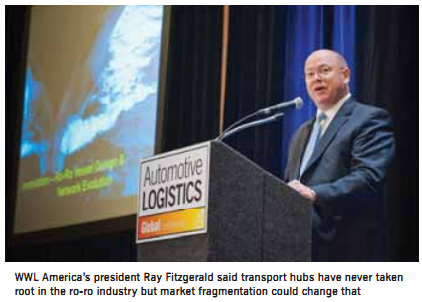 This is largely down to the regional nature of the business of shipping vehicles to the dealerships. “Every time we see that [empty rail return] we think there has got to be a better way to handle this and reduce those empty miles,” said Powers. He went on to say that the port had talked to importers in the past about the use of inland hubs, which would allow the ocean vessels to discharge the vehicles directly for rail shipment to an inland point, from where final delivery could then be executed by truck. However, that talk has not amounted to much. “I don’t think you can do it door-to-door but if you use that idea of an inland hub maybe that is a possibility, but there doesn’t seem to be a lot of interest in that these days.”
This is largely down to the regional nature of the business of shipping vehicles to the dealerships. “Every time we see that [empty rail return] we think there has got to be a better way to handle this and reduce those empty miles,” said Powers. He went on to say that the port had talked to importers in the past about the use of inland hubs, which would allow the ocean vessels to discharge the vehicles directly for rail shipment to an inland point, from where final delivery could then be executed by truck. However, that talk has not amounted to much. “I don’t think you can do it door-to-door but if you use that idea of an inland hub maybe that is a possibility, but there doesn’t seem to be a lot of interest in that these days.”
 This point was backed up by Timothy Butt, market manager for automotive at rail provider Norfolk Southern, who said that one way to encourage such hubs would be for OEMs to engage more with the “co-mingling of vehicles”, a solution he said the rail carriers were already practising. “ There have got to be some savings in the network if we are able to mix vehicles and use the assets that are already at the port to move the vehicles closer to the ultimate destination,” he said.
This point was backed up by Timothy Butt, market manager for automotive at rail provider Norfolk Southern, who said that one way to encourage such hubs would be for OEMs to engage more with the “co-mingling of vehicles”, a solution he said the rail carriers were already practising. “ There have got to be some savings in the network if we are able to mix vehicles and use the assets that are already at the port to move the vehicles closer to the ultimate destination,” he said.
Dynamic ETA and visibility
Others at the conference also pointed to gaps in delivery visibility right up to the dealer or end customer. Wes Lutz, president of the Michigan Automobile Dealers Association, said accurate delivery information and a reliable ETA were crucial and could mean the difference between making $800 gross profit per vehicle or not. “I’m assigned to move cars at a certain pace and if we don’t have reliable information it makes a huge difference to our financial business model in the dealership,” he said. Lutz said there were lags in the system with periods up to five days without notification of a vehicle’s whereabouts, which is a problem for dealers with 30-day sales programmes.
“We receive really good reports right now showing where our vehicles are, but they are just not accurate,” he quipped. GM’s Anthony Clevio, operations manager at GMNA and intercontinental logistics at the time of the conference (he has since moved to a role in order management), revealed that big changes were underway at the company to enhance the quality of this sort of information, namely via its Autowork bench application. Clevio said that the system could previously only show a limited number of events in the delivery process, such as when it left the assembly plant and when it was due to arrive at the dealer, leaving a two-to-three week timeframe in between.
“The big change that took place [in 2011] was to include all of the logistics events in our workbench applications for our dealers,” said Clevio. “They can now see every movement of the vehicle from the factory to its delivery, including the handling and the carrier that is associated with it.” The next change will be to introduce what Clevio called a “dynamic ETA” to give the dealers enhanced accuracy on the arrival of the vehicle. “Today the dealer has visibility about where the vehicle is but they don’t have an ETA and it is certainly not dynamic, so that is our next big step,” he said. Clevio said that the push to transform the visibility of the delivery process would be driven by the fleet side of GM’s business, such as rental agencies, where accurate delivery information is crucial to such customers’ business planning. “[Fleet customers] want the asset in service as soon as it gets to the dealership,” he said. “If they don’t know when it gets there, they have to react accordingly and make sure it starts generating revenue when it does get there.”
Electronic data sharing
The efforts to remedy this lack of accuracy also include information about damages, which can lead to delays. “This year we have set up a damage prevention group in vehicle operations to focus on more accurate and timely ways of knowing when the vehicle is going to be delivered to the dealer, as well as how it is delivered, including transport damage awareness,” said Chrysler’s damage prevention and claims manager Erika Mercado-Gratton. When Chrysler receives delivery notifications, they are often already two to five days old, according to Mercado-Gratton. Chrysler is now working on enhancing its electronic proof of delivery to answer when and how the vehicles are being delivered, adding greater visibility to the last leg of the delivery process.
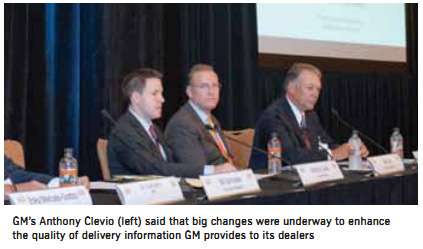 Mercado-Gratton went on to detail how the company had recently completed a two-week trial in the southeast region of the US and received good feedback from carriers, dealers and drivers. “We need to get more carriers on board [with electronic proof of delivery] in other regions such as the West Coast and Midwest,” she said.
Mercado-Gratton went on to detail how the company had recently completed a two-week trial in the southeast region of the US and received good feedback from carriers, dealers and drivers. “We need to get more carriers on board [with electronic proof of delivery] in other regions such as the West Coast and Midwest,” she said.
A new associationIn an effort to encourage further communication on the trucking side of the business, Bill Shroeder introduced a new carrier interest group called the Auto Haulers Association of America, which was founded this past year by companies including Proficient Auto Transport, Amerifleet and Brothers Auto Transport, among others. Shroeder, who is general manager of the group, said its mission was to promote information sharing and the establishment of best practices for improved operational performance among small- to medium-sized car carriers in North America.
He said that products and services include a website that pushes out news about trucking, supplied by a comprehensive list of group members, as well as forums to discuss issues raised by day-to-day operations and a focus on standards and services, such as driver recruitment and training, operational and financial tools.
A flexible future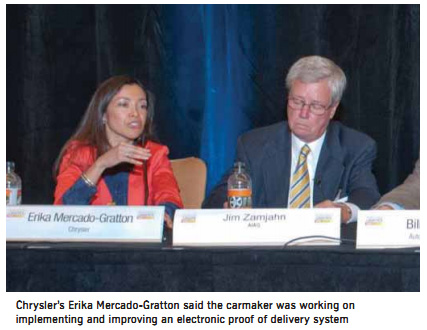
Among the issues stressed at the event was the need to share more long-term forecasts, not only to plan capacity moves but also to make the right equipment investments. GM pointed to plans for sharing forecasts up to five years out or more. Toyota’s Mike Nelson, however, highlighted the difficulty in predicting consumer demand not only in volume but also in product type. Because of dramatic swings between car and SUV demand, many OEMs have allowed for more production variability in their plants. Toyota’s factories, for example, now have the ability to switch within six months from making trucks like the Sequoia to small cars like the Corolla, and vice-versa. But the question was how the transport industry mightkeep up with this flexibility. “The challenge on the supply chain side is if, all of a sudden, we go in an opposite direction as an industry – say, from smaller cars to larger trucks or vice-versa – we would then be locked in, particularly on the rail side, when it comes to investment,” Nelson said. “We may end up on the wrong side of the fence with a bunch of railcars that we can’t use because the market has changed.” A longer report on the conference can be found at www.automotivelogisticsglobal.com.

























![Global[1]](https://d3n5uof8vony13.cloudfront.net/Pictures/web/a/d/s/global1_726550.svgz)









